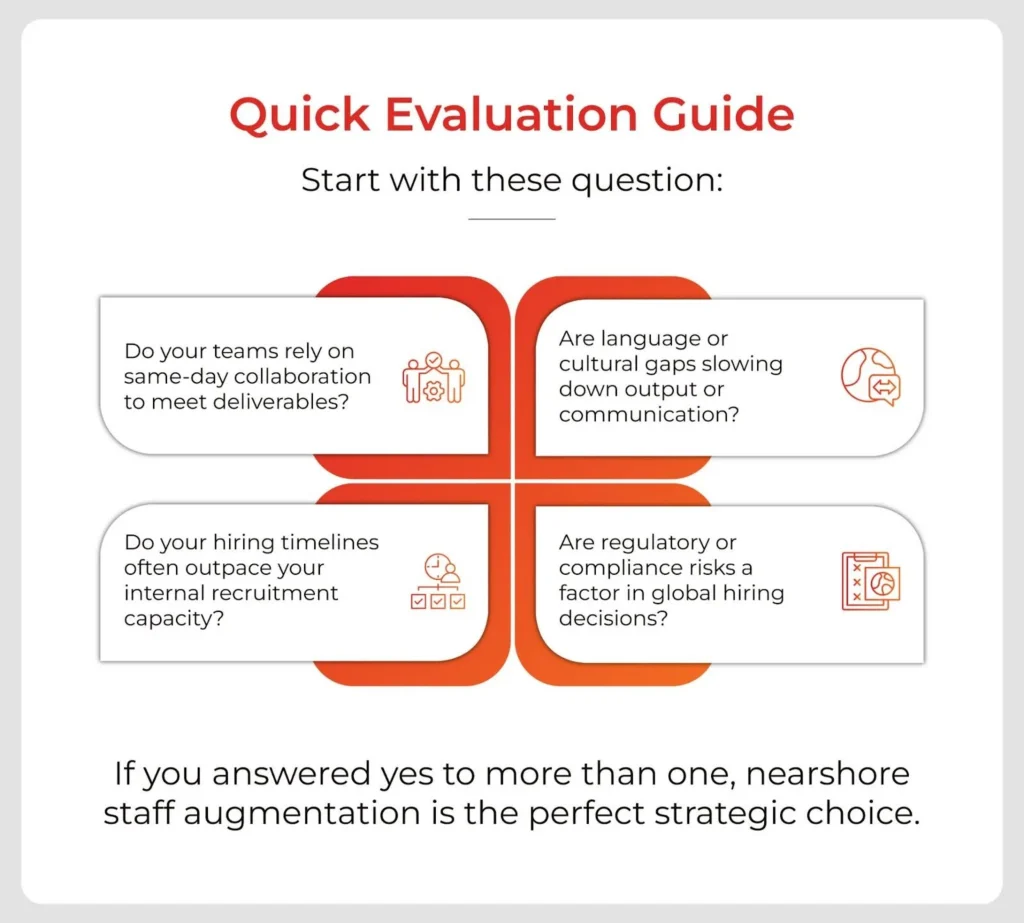Nearshore staffing refers to hiring skilled professionals from neighboring or nearby countries, typically within the same or adjacent time zones. The idea is for them to work as an extension of your in-house team. This model offers the benefits of geographic proximity, cultural compatibility, and real-time collaboration, without the high costs of onshore hiring or the time-zone hurdles of offshore models.
Hiring has become more than a race for talent. It’s a test of operational agility. For today’s HR and talent acquisition leaders, speed alone isn’t enough. You need the right people, ready to contribute, without compromising collaboration or control.
Traditional hiring models (onshore, offshore, in-house) still hold their ground. But as workforce trends and strategies evolve, the gap between availability and accessibility is widening. The hiring challenge doesn’t lie in the lack of talent, but a lack of alignment (in time zones, working styles, and delivery timelines).
That’s where nearshore staffing earns its place.
By working with teams in nearby countries, typically in similar time zones, companies gain access to skilled professionals who can operate in sync with internal teams. Apart from cost-efficiency, this model benefits from real-time communication, shorter feedback loops, and cultural alignment that accelerates performance from day one.
If your business is scaling tech, expanding shared services, or building out operational support, nearshore staffing may be the most strategic move.
In this guide, we’ll break down how the model works, where it delivers the most impact, and how to evaluate if it fits your long-term workforce plan.
What Is Nearshore Staffing and Why Is It Gaining Momentum?
Nearshoring has evolved from a cost-saving tactic into a strategic pillar for high-growth teams seeking agility and scalability. As global hiring gets more complex, nearshore staffing offers something traditional models often can’t: real-time alignment without losing global reach.
A 2024 Deloitte Global Outsourcing Survey found that 83% of executives are redesigning outsourcing strategies to prioritize agility, responsiveness, and real-time collaboration, exactly where nearshoring excels.
So, what exactly is nearshore staffing?
At its core, nearshore staffing involves hiring talent from countries that are geographically close and operate in similar time zones, often within a 2–4 hour range of your headquarters. Unlike offshore staffing, where time zone differences can delay progress, nearshoring gives your team the benefit of live collaboration, same-day responses, and faster decision-making.
But proximity alone isn’t what’s driving adoption.
It is taking off now because the world is now remote-first, and synchronous collaboration matters more than ever. Distributed teams still need to work in sync, especially in roles where daily alignment, quick iteration, or tight deadlines are non-negotiable. That’s where nearshoring stands apart.
Add to that the growing maturity of talent ecosystems in Latin America, Eastern Europe, and Southeast Asia, and you now have access to skilled professionals who bring not only technical strength but also cultural fluency and linguistic ease, especially when supporting U.S. and European clients.
Nearshore Staff Augmentation: How It Works and When to Use It
Not every role needs a full offshore team, and not every project justifies a permanent hire. That’s where nearshore staff augmentation becomes the most flexible and scalable way to build capability, without the overhead of traditional hiring.
It is a hiring model where companies temporarily integrate skilled professionals from nearby countries into their teams. Unlike full outsourcing, where ownership of delivery shifts to a third party, this model gives you direct control over tasks, timelines, and tools, with the added advantage of timezone compatibility and cultural alignment.
It’s not about replacing internal teams, but expanding bandwidth on demand while staying agile. You’re not locked into long-term contracts. You keep control of your processes. And you gain access to specialists who can plug into your system fast, often in under three weeks.
So, what Makes It Different from Outsourcing? The distinction lies in ownership and integration.
In traditional outsourcing, deliverables are managed externally. You hand off the “what” and “when,” but rarely the “how.” In nearshore staff augmentation, the “how” stays with you. These professionals work as an extension of your in-house team, fully embedded in your day-to-day flow, communication tools, and team rituals.
It’s not vendor management, but talent collaboration (just distributed).
Nearshore staff augmentation is particularly effective in:
- Product launches that require time-bound execution and fast iteration
- Short-term demand spikes, like seasonal campaigns or system rollouts
- Specialist roles that are hard to fill internally but don’t require permanent hires
- Pilot teams to test new functions or markets without long-term risk
Here’s a practical example:
A U.S.-based SaaS company needed to scale its QA function for a feature release. Instead of overburdening internal teams or hiring permanent testers, they partnered with a nearshore staffing company in Mexico. Within 3 weeks, the team ramped up, aligned on workflows, and began testing cycles in real time, with zero handoff lag.
That’s the edge nearshore staff augmentation delivers: speed without silos.
Nearshore vs. Offshore vs. Onshore: What’s Right for Your Hiring Goals?
Choosing between nearshore, offshore, and onshore hiring isn’t about which model is best. It’s about which model best fits your team’s goals and the constraints you’re working within.
Some roles demand high collaboration. Others require cost containment or compliance support. What works for a product sprint may not work for customer support. The key is to match the model to the function and not the other way around.
Let’s break it down.
Nearshore Staffing
Best for: Teams that require real-time collaboration, faster onboarding, and cultural alignment.
Nearshore staffing offers timezone overlap, better communication, and faster iteration. It works especially well for product teams, cross-border operations, and any function that requires speed and integration. You get talent that’s close enough to work live, but at a lower cost than onshore hiring.
Offshore Staffing
Best for: Cost-driven projects with lower collaboration needs or where overnight delivery is an advantage.
Offshore models are typically more budget-friendly, but the trade-off is in responsiveness. Time differences can delay decisions. Communication gaps are common. This model suits functions like testing, documentation, or maintenance, where work can happen asynchronously.
Onshore Hiring
Best for: Compliance-sensitive, customer-facing, or leadership roles that require in-person context or full timezone overlap.
Onshore hiring offers the highest control and cultural alignment, but also the highest cost. It’s ideal when proximity is critical, not just helpful.
| Model | Timezone Overlap | Cost | Speed to Onboard | Collaboration Quality | Best For |
| Nearshore | High | Moderate | Fast (2–4 weeks) | Strong | Agile teams, customer success, analytics |
| Offshore | Low | Low | Slower (3–6 weeks) | Medium to Low | Back-end ops, testing, round-the-clock tasks |
| Onshore | Full | High | Moderate | Strongest | Compliance, executive roles, in-person work |
What Should Drive Your Choice?
When making the decision, ask:
- Will timezone lag slow down my team?
- Is cultural alignment critical to performance?
- Do we need full ownership of the process and delivery?
- What’s the cost of delay compared to the cost of talent?
Nearshore IT staffing tends to strike the best balance for most high-collaboration roles. It gives you real-time access to top-tier professionals, without the friction of distance or the premium of local hires.
Benefits of Nearshoring Staffing for Agile Teams
Agility is all about moving with purpose, alignment, and the right resources in place. That’s exactly where nearshoring staffing creates value.
While cost savings are often the first draw, they’re rarely the lasting advantage. For fast-moving teams, nearshore staffing offers a broader set of operational and strategic benefits that go well beyond budget.
Below are some benefits of nearshore staffing for agile teams:
Faster Hiring Cycles
You don’t have months to fill key roles, especially in competitive markets. With a mature nearshore staffing company, talent pipelines are already in place.
Think pre-vetted candidates, regional expertise, and less red tape.
Hiring cycles that might take 8–10 weeks onshore can shrink to 2–4 weeks nearshore, without compromising quality.
Cultural & Linguistic Alignment
Working across borders doesn’t have to mean working against friction.
Nearshore teams typically share more cultural alignment with your home country than offshore teams, including language fluency, business etiquette, and work styles.
That alignment makes collaboration smoother. It reduces rework. It also helps with stakeholder buy-in, especially when client-facing communication is involved.
Better Retention vs Offshore
Employee churn kills continuity. Offshore teams often face higher turnover due to pay disparities, limited engagement, or mismatched expectations.
Nearshore teams, particularly in Latin America and Eastern Europe, show stronger retention rates.
Why? Because their alignment with U.S. and EU work cultures leads to better team fit and job satisfaction.
Lower churn means less retraining, fewer interruptions, and more momentum.
Seamless Collaboration in Same-Day Zones
This is where nearshoring truly shines.
Timezone alignment isn’t just about convenience. It impacts every part of your delivery cycle, including stand-ups, reviews, last-minute pivots, and client escalations.
When your engineers, analysts, or support reps are operating live, not 10 hours apart, collaboration feels like an extension, not outsourcing.
Regulatory Comfort
Working with a nearshore staffing company also means easier legal compliance, especially in heavily regulated industries.
Labor laws in nearshore regions often resemble or integrate with U.S. and EU frameworks, making it easier to align on contracts, IP protection, and labor rights.
For HR leaders, this translates into lower risk and fewer cross-border surprises.
Where Nearshore Staffing Delivers the Most Impact
Nearshoring isn’t a one-size-fits-all solution, and that’s exactly what makes it powerful. Its true value shows up when applied to the right hiring situations.
Whether you’re building out capabilities, solving bandwidth issues, or bridging gaps between markets, nearshore staffing is most impactful when timing, talent, and team integration need to align fast.
Below are common scenarios where nearshore staff augmentation offers a clear edge:
- Confidential or complex hiring
When discretion is essential, like for leadership transitions, stealth projects, or regulatory work, nearshore hiring offers more control than offshore alternatives and more flexibility than in-house processes.
- Cross-border teams that require timezone overlap
Distributed doesn’t have to mean disconnected. If your internal teams are spread across North America or Europe, working with professionals in nearshore locations ensures real-time collaboration and responsiveness.
- Support roles that demand cultural and linguistic proximity
For customer success, multilingual support, or operations that involve direct communication with end-users, nearshore teams often deliver a higher-quality experience, one that reflects your brand voice more naturally.
- High-volume scale-ups with tight hiring timelines
Need 20+ roles filled in 4–6 weeks? Nearshore staffing companies typically have deep benches and regional talent networks that allow rapid scale-up without compromising skill requirements.
- CX and tech ramp-ups that require embedded alignment
Whether you’re launching a new feature or expanding into a new market, nearshore teams are more easily embedded into your rituals, tools, and communication channels, especially compared to siloed offshore teams.
Quick Evaluation Guide to check whether nearshore staffing is the right fit

Choosing the Best Nearshore Staffing Partner: What to Look For
Nearshore staffing works, but only when your partner does too.
The success of your hiring model depends less on geography and more on execution. That’s why choosing the best nearshore staffing partner is just as strategic as selecting the right roles to nearshore.
You’re looking for a long-term collaborator, one who can deliver speed without shortcuts, and alignment without micromanagement.
Experienced nearshore providers don’t just talk about scale. They demonstrate alignment, operationally, culturally, and legally. Here’s what to look for:
- Transparent SLAs
Timelines, candidate quality, and escalation points should all be clearly defined. No ambiguity, no backpedaling. - Language-tested candidates
Especially for client-facing roles or high-collaboration teams, fluency isn’t optional. Reputable firms validate this upfront, not post-hire. - Regional compliance expertise
Labor laws vary, and so do expectations around contracts, IP protection, and benefits. Your partner should have on-the-ground legal insight and operational controls in place. - Role-specific pipelines
If you’re hiring engineers, analysts, or multilingual CX talent, you need a partner with focused talent pools and not a generalist directory.
When these foundations are in place, you’re building continuity without taking on unnecessary risk or complexity.
Red Flags to Watch For
Equally important: know what to avoid. These signs often signal future delivery gaps:
- Overpromising on timelines
“We can staff 10 roles in 5 days” sounds impressive, until day 7 arrives and you’re still screening résumés. Credible partners offer speed and realism. - Limited or no local presence
If they’re offering services in Mexico, Colombia, or Eastern Europe, ask if they operate there. Without boots on the ground, quality control suffers. - No post-hire engagement
A good nearshore staffing company doesn’t disappear after placement. Ongoing check-ins, issue resolution, and retention support should be part of the model.
Selecting the right partner is a talent strategy move. Choose a partner who treats your goals as their KPIs, not just a contract to fulfill.
Conclusion: Rethinking Your Talent Strategy with Nearshore Staffing
Nearshore staffing is a strategic move in workforce planning, especially for companies navigating global expansion, remote-first workforces, or product-led growth.
Looking ahead, we see nearshore staffing evolving from a backup plan to a first-choice model, not just for IT, but for roles across compliance, design, finance, and customer success. The organizations that succeed won’t be those with the biggest teams, but those that know where to place them.
If your team is revisiting its workforce architecture in 2025, consider this your invitation to reframe the question: not “how do we hire faster,” but “where can we build better?”
At SPECTRAFORCE, we specialize in helping global businesses build high-performing teams through nearshore staffing. From tech to operations, our clients trust us for:
- High-quality, culturally aligned talent
- Rapid ramp-up (2–4 weeks)
- Flexible engagement models (staff augmentation, dedicated teams)
- Pay-on-hire options and full compliance coverage
Ready to unlock faster, more agile hiring?
Talk to a nearshore staffing expert at SPECTRAFORCE and discover how we can help you scale smart, with talent that works in sync with your team, your tools, and your time zone.
FAQs
Nearshore staff augmentation fills various types of roles. It supports far more than just engineering. While roles like software development, DevOps, QA, and UI/UX are among the most common, that’s only one part of the picture.
Many organizations use nearshore talent for data analytics, project management, multilingual customer support, financial operations, and compliance-heavy functions. These roles benefit from tight collaboration, fast response cycles, and contextual awareness, all of which are harder to achieve with distant offshore models.
If a role demands real-time communication, cultural alignment, or cross-functional integration, nearshore staffing is often the smarter choice.
No, nearshore staffing is not only for IT companies. While nearshore IT staffing has seen the fastest growth, the model is now used widely across industries. Healthcare providers use it to support administrative, billing, and data teams. Financial institutions tap into nearshore markets for risk and operations roles. E-commerce and logistics firms rely on it for multilingual support and analytics.
In short, any company that needs highly skilled professionals and values timezone compatibility, faster onboarding, and seamless collaboration can benefit from nearshore staffing services.
To choose the best nearshore staffing partner, don’t start with scale, start with fit. The best nearshore staffing company will help you build continuity.
Here’s what to look for:
Regional expertise and a strong local presence
1. Language fluency and cultural compatibility
2. Flexible engagement models (e.g., staff augmentation, dedicated pods)
3. Transparent pricing and clear SLAs
4. Proven delivery history and low attrition rates
Ask them to walk you through their hiring funnel. Request sample candidate profiles. A reliable partner won’t just tell you they can deliver, they’ll show you how.
Nearshore IT staffing and offshore are very different despite both aiming to expand your talent pool.
Nearshore IT staffing gives you access to teams in the same or adjacent time zones. That means same-day collaboration, faster feedback, and real-time problem-solving. Communication is easier, onboarding is smoother, and projects stay on track because you’re working live.
Offshore models, while often cost-effective, require more asynchronous management and heavier process control. The 8–12 hour time gap can slow down decision-making and lead to missed context, especially in high-collaboration environments.
In contrast, nearshore IT staffing acts as an extension of your in-house team, not just a vendor operating overnight.
Yes, nearshore staffing can help with long-term hiring needs, and more companies are using it that way every year.
Nearshore staffing isn’t just a stopgap for temporary roles or short-term spikes. It’s becoming central to long-term workforce planning. Businesses are building full-scale, nearshore teams across product development, customer experience, data science, finance, and more.
What makes it work long-term? Retention is stronger. Time zones are aligned. And cultural fit is often better than with distant offshore setups. All of that leads to tighter integration with your core team, without the overhead of global relocation or satellite office management.
In many cases, nearshore staffing becomes a permanent part of the talent strategy, not just a quick fix.



